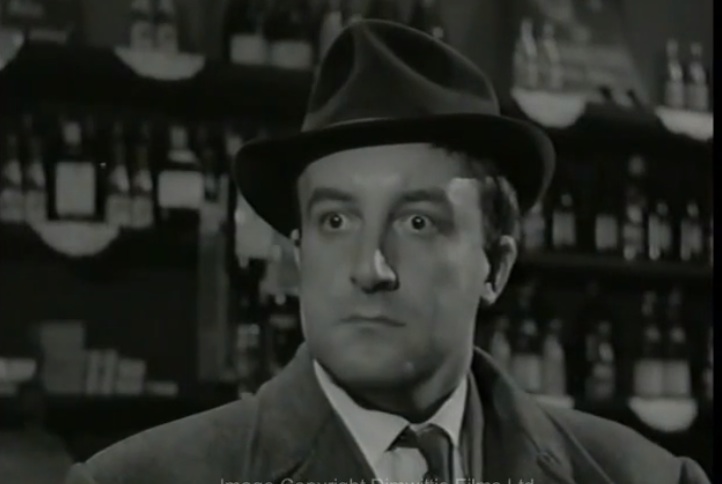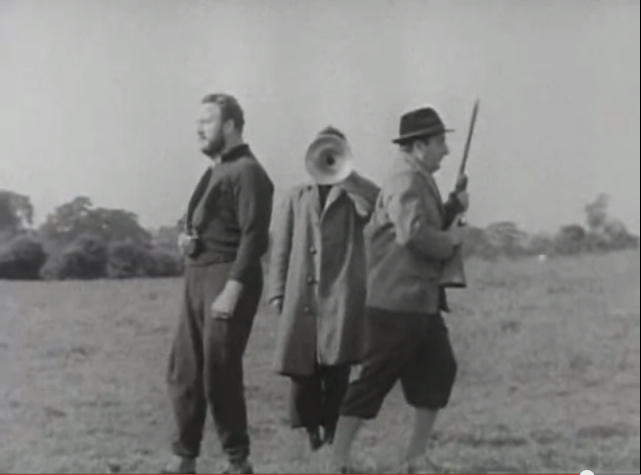Click here to print
Peter Sellers Skips from a Dumpster
posted May 1, 2014
Two early films long considered lost forever re-emerge to show the master comic at a turning in his career
n
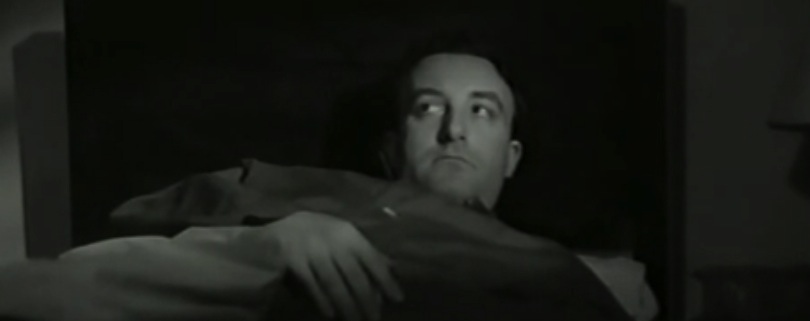
n
Two long-lost films from the beginning of Peter Sellers’ career that have not been shown publicly in 57 years have just been screened again. But only after surviving by unlikely good fortune.
The two films, Dearth of a Salesman and Insomnia Is Good for You, first hit screens (although, not many) in 1957, while Sellers was in his mid-30s and had not yet become a film star. For decades they have been believed lost forever because they had been unsighted for so long.
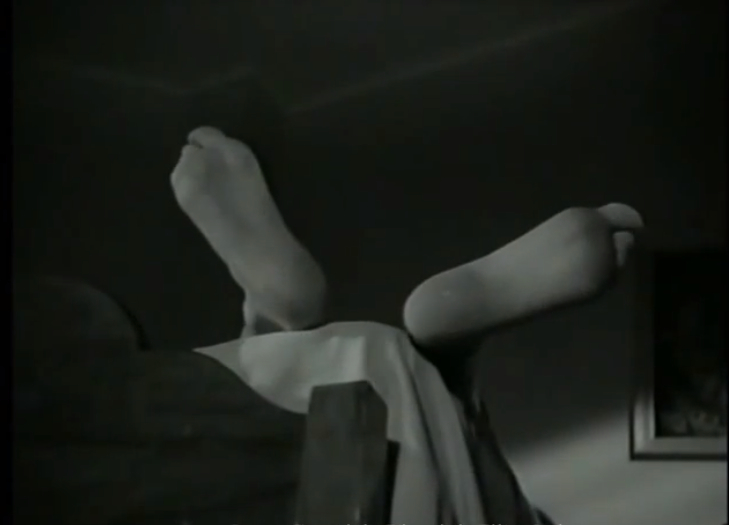
Peter Sellers, as a thorough dimwit, attempts to get a few zzz’s with advanced insomniac’s positions.
In 1996, Robert Farrow, a London building manager, found the films on 21 reels in a skip [dumpster] behind Quadrex House in London’s Mayfair, which had been the headquarters of the Park Lane Films production company that made the films. But he did not realize what he had recovered; so, as he told reporters in 2013, he “put them in a cupboard and pretty much forgot about them.”
 He added: “During a recent clear-out, I found them … and decided to see what the tins contained. It was then I realised they were two Sellers films, including the negatives, titles, show prints, outtakes and the master print. It was amazing.”
He added: “During a recent clear-out, I found them … and decided to see what the tins contained. It was then I realised they were two Sellers films, including the negatives, titles, show prints, outtakes and the master print. It was amazing.”
Negatives, title sequences, out-takes, and prints — the films’ babies and bathwater!
Farrow told the BBC last year that he had at one point thought about throwing the films away after deciding the cans “would be good for storing my Super 8 collection in,” and admitted he had considered simply throwing the films out but instead put them in a cupboard and forgot about them until a spring cleaning last year. “It was then I realised they were two Sellers films including the negatives, titles, show prints, outtakes and the master print. It was amazing.”
He showed the 30-minute shorts to Paul Cotgrove, from The White Bus, the organization that runs the annual Southend-on-Sea film festival. (It will also host its second Horror-on-Sea Film Festival in January 2015.) He and Stephen Podgorney set up a company, Dimwittie Films, to handle the discovered reels — to give them a telecine scan and from that create a digital cinema print.
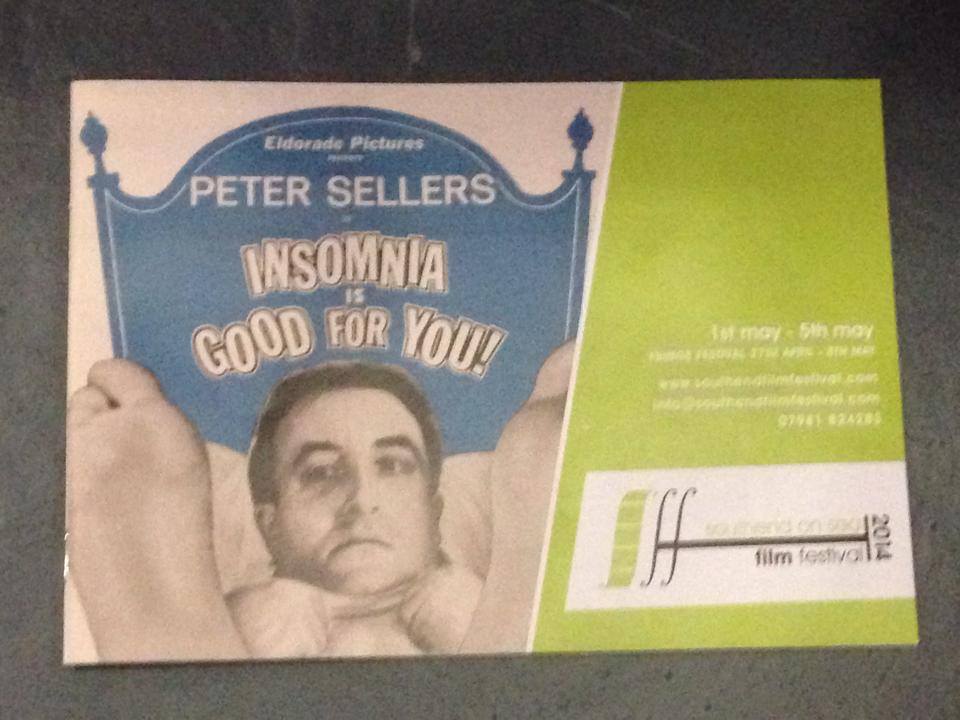
The program for the Southend-on-Sea Film Festival 2014
Dimwittie Films will rent the digital version for public screenings to raise money to have the film stock restored — on film stock. But meanwhile it is the digital restoration that is set to open the Southend festival today, 1 May 2014, at a sold-out screening, with a repeat presentation set for 5 May 2014. (Both films will also be screened at the Niagara Integrated Film Festival in Ontario, which runs 19-22 June 2014.)
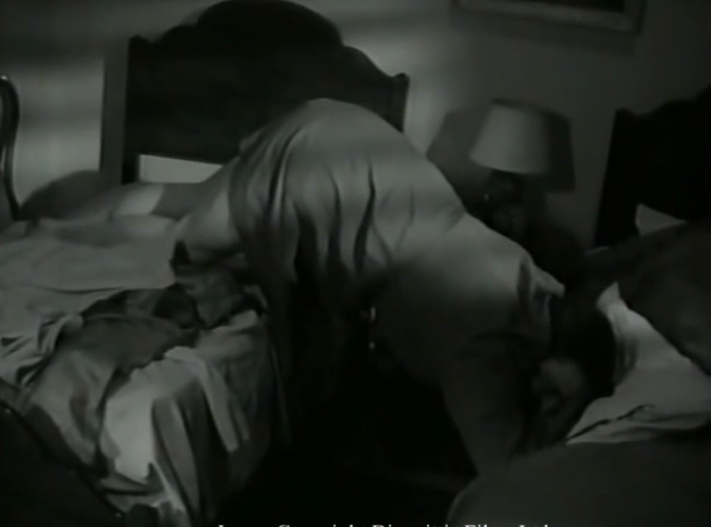
Dimwittie tries yet another sleep posture…
At a press screening last week (23 April 2014), Farrow told reviewers: “I suppose I could have put them on Ebay. People kept telling me I should, but I really wanted to find the right home for them. I tried talking to various people over the years but I wasn’t talking to the right people. I didn’t bother much after that and left them in a cupboard under the stairs and forgot about them. Eventually, I thought I ought to do something, so I contacted our local film festival.
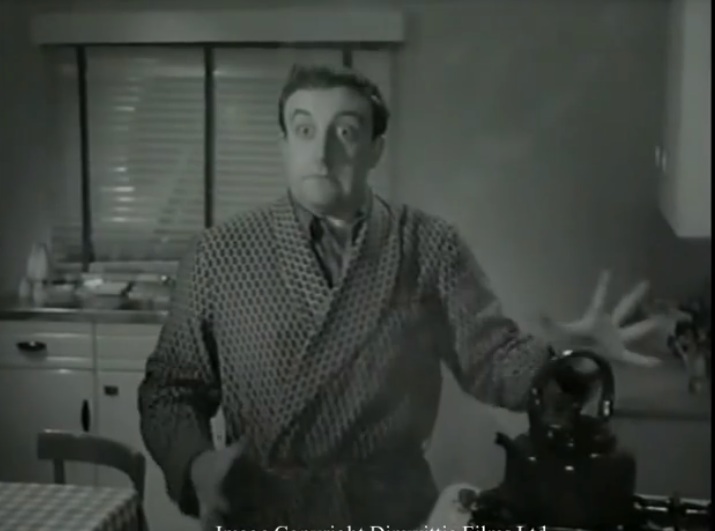
…and demonstrates the hazards of sleeplessness while attempting to make a cup of tea. (Click on image to view film.)
“I’m ecstatic they’re finally getting the showing they deserve.”
At the time Farrow identified the film and transferred it to Cotgrove’s organization, some British film programmers hailed the find as the film equivalent of finding the Dead Sea Scrolls. No doubt that was hyperbole. “They’re not riotous comedy, they’re just good fun to look at,” Cotgrove told the BBC last year (2013). He called them “kind of a pastiche of the public information films at the time.” Sellers played multiple roles in each film and seems to have viewed the shorts almost as “show reels” to demonstrate “his considerable talents” at a time when he was testing his craft, Cotgrove said.
Dearth of a Salesman sees Sellers play Hector Dimwittie as he attempts to become the most successful salesman in Britain. He plays the same character, among others, in Insomnia Is Good for You, this time as his anxiety builds and he struggles to sleep ahead of a crunch meeting with his boss.
Roger Lewis, who wrote a biography of the brilliant but to-put-it-mildly difficult humorist, The Life and Death of Peter Sellers, explained the significance of the finds in an essay published in Express on 27 April 2014. He said that although he had heard of the films, he had seen only a third in the series, Cold Comfort, in circumstances that drove home how remote seemed his chances of viewing the two now-found shorts: “A slightly sinister man living in a mouldering bungalow under the Gatwick flight path had once shown me a Betamax copy,” he said.
He wrote: “Directed by Leslie Arliss these modest productions were parodies of public information films, the government-commissioned shorts shown during advertising breaks on television or in cinemas before the main feature.”
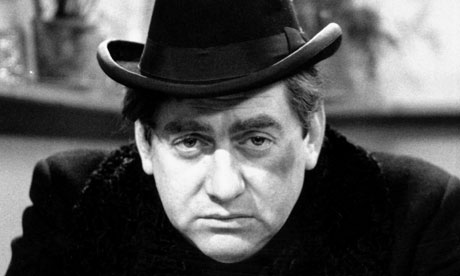
Although inimitable, fellow British comic Tony Hancock much inspired the young Peter Sellers
Clearly, he notes, Sellers drew heavily on British acting eccentric, Tony Hancock: “Sellers (like Hancock) was instinctively attuned to the humour underlying the chirpy Keep Calm and Carry On/Mustn’t Grumble philosophy.”
Dearth of a Salesman saw Sellers play Hector Dimwittie, who attempts to become the most successful salesman in Britain, vainly trying to sell goods from toilet supplies to tape recorders. “Sellers works hard,” Today’s Cinema said at the time, before adding that there was “handy footage appeal.”
The dimwit Dimwittie also featured in Insomnia Is Good for You, this time as a hapless fellow unable to sleep over a forthcoming meeting with his boss.
Dimwittie, says Lewis, is like his later Inspector Clouseau: he “always comes a cropper” and “is the irrepressible Everyman who causes trouble by trying to stay out of it. In the film about how to avoid the flu [the two films’ companion piece, Cold Comfort] he succumbs to coughs and sneezes in the final fast-fade. Demonstrating how to be a successful door-to-door salesman he covers a householder in paint. Advertising the virtues of a good night’s kip he is tormented by bad dreams and finally drops off when at work.”
Lewis is not among those who would hail the rediscovery of the films a Dead Sea Scrolls-like event: “No one will claim these rediscovered films are in the Orson Welles class but what we do see is, firstly, London in the 1950s, the post-war murk of boarding houses, sootiness, and smoke. Secondly, we can see Sellers the pudgy radio star beginning to evolve.”
Above: Sellers as the dimwitted Dimwittee demonstrates why you wouldn’t want to buy paint from him in Dearth of a Salesman, and then (below) he demonstrates the unsleeping positions that prove that “a soft warm bed is the insomniac’s battleground.”
Sellers wrote both films with Canadian novelist Mordecai Richler, then a 26-year-old living in London, and who later wrote The Apprenticeship of Duddy Kravitz and Barney’s Version. Sellers was determined to achieve the success in film that he soon did. In the United Sates, he became best known for his appearances in the international-hit Pink Panther films of Blake Edwards as well as Stanley Kubrick’s farce macabre Dr. Strangelove. Years before making these films, however, he had become a well-known comic actor on radio for the hugely successful series, The Goon Show, in which he had been appearing since 1951 with Spike Milligan, Harry Secombe, and other iconoclasts of British radio of the day.
The two restored short films, says BBC arts editor Will Gompertz, “capture Sellers at a career crossroads,” he says. “He’s nailed the radio with The Goons, and made a good start in TV and film. Now he wants to be a screen star. They feel more like a TV sit-com than short movies. A pilot ‘Peter Sellers half-hour’ perhaps, to rival Tony Hancock’s, which had successfully transferred to telly the year earlier.”
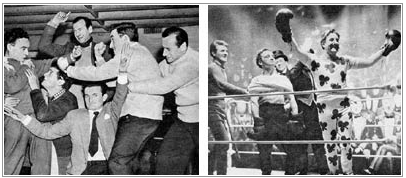
Spike Milligan wrote most of the material for “The Idiot Weekly, Price 2d” which was named for a tatty newspaper whose headlines prompted the show’s wacko sketches. Peter Sellers played the editor, and he and Milligan headed a cast largely comprised of fellow Goons: Eric Sykes, Kenneth Connor, Graham Stark, Valentine Dyall, June Whitfield and Max Geldray.
In the UK, the BBC aired The Goon Show, while the BBC Transcription Services distributed it throughout the British Commonwealth. It had fared so well that in 1956 Sellers adapted the style and spirit of its humour for a television series, The Idiot Weekly, Price 2d for Associated-Rediffusion, England’s first independent television broadcaster whose range was limited to London and its environs. Its fortunes were markedly more modest.
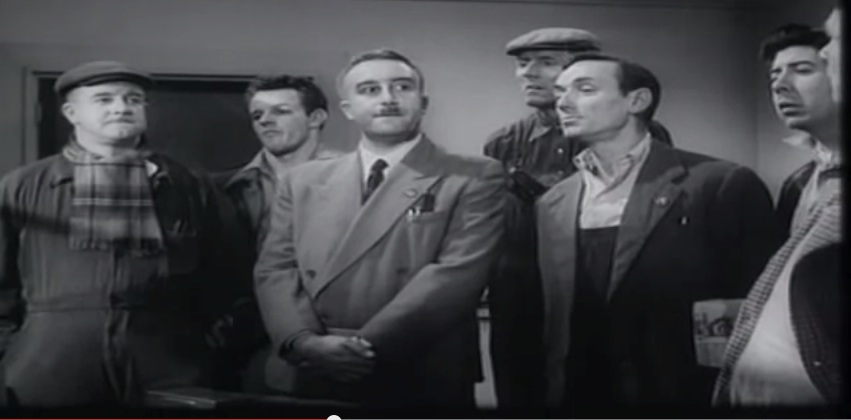
Sellers as Fred Kite, the union man.
By 1957, notes biographer Lewis, Sellers was earning a handsome wage, and living in Whetstone, North London, with a wife (not his last) and children. He had appeared in cameo film roles, and two years later, in 1959, he produced a bumper crop. He appeared in The Running Jumping and Standing Still Film and his first big hit I’m All Right Jack, alongside the likes of Ian Carmichael, and in which director Roy Boulting cast him as union man Fred Kite, and he played the part so well that soon he was the star of prison capers, Foreign Office spoofs, and religious satire, says Lewis, who adds: “The guardians of political correctness would not permit this today but when he blacked-up to play an Asian doctor opposite Sophia Loren in The Millionairess in 1960 he became an international star.”
More Sellers to come?
The recovery of the two shorts is the latest but not necessarily the last Sellers revelation. In July 2009 the British Film Institute completed a restoration of Penny Points to Paradise, the 1951 feature-film debut of Sellers and two other imminent stars of The Goon Show, Spike Milligan and Harry Secombe. They play characters in a Brighton seaside escapade that leads them to shenanigans in a waxworks.
Sellers called it “a terrifyingly bad film” barely worth the paltry £33 it bought him. Mark Brown of The Guardian was a little more generous, describing it as “an amiable seaside crime caper” in which Sellers played both an old major and a smooth-talking salesman, Arnold P Fringe. Harry Secombe played a gormless pools winner while Spike Milligan portrayed his best friend.
BFI curator Vic Pratt called Penny Points to Paradise (which sometimes was billed as Double or Quits) a significant find and restoration — a “missing link in British comedy history.” He told The Guardian: “The film captures the moment as they are about to revolutionise comedy with The Goon Show and it’s really important for that reason.” Peter Sellers, he said, was clearly “a talent that was fully formed from the beginning and he clearly knows how to use the camera.”
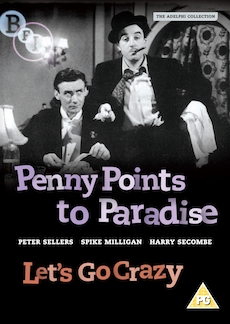 The film’s history had been complicated by efforts to improve it, post-initial release.
The film’s history had been complicated by efforts to improve it, post-initial release.
The film’s opening, 1955 run was unprofitable, so when preparing a reissue in 1960 for foreign distribution, producers saw fit to tinker with the original film — they shortened it to 55 minutes, and spliced in another comedy short that had featured Sellers, Let’s Go Crazy. (A print of that bowdlerized version much later turned up in the National Film and Sound Archive of Australia.)
Jump forward to 2006: while sifting through material once stored in Adelphi’s production office, Kate Lees, granddaughter of Adelphi Films’ boss Arthur Dent, discovered two ragged reels of 16mm film labelled “Penny Points to Paradise.” That led to a 2007 BFI restoration that was, at 64 minutes, still only partial.
But that in turn prompted a fuller BFI restoration: a 72-minute reconstruction drawn from the 16mm print and various incomplete 35mm fragments from various archives.
Laura Camuti, an American fan of Sellers who had grown up loving the Pink Panther movies, underwrote a restoration. In a BFI announcement, she said: “I became aware of how much of his career I didn’t know about. I didn’t know about The Goon Show, for example.”
 The BFI screened this 72-minute Penny Points to Paradise in July 2009 and quickly also released high-definition DVD and Blu-Ray packages that included that restoration — which BFI curator Vic Pratt described as “a cheap and cheerful film” — along with the associated short, Let’s Go Crazy, which was knocked out in the week that remained after Penny Points to Paradise took only three of four weeks of studio rental. In a variety of over-the-top restaurant comedy sketches, the three Goons play multiple roles — Sellers’ go by such names as Crystal Jollibottom and Izzy Gozunk. Milligan plays an early version of the bizarrely uproarious Eccles character of The Goon Show.
The BFI screened this 72-minute Penny Points to Paradise in July 2009 and quickly also released high-definition DVD and Blu-Ray packages that included that restoration — which BFI curator Vic Pratt described as “a cheap and cheerful film” — along with the associated short, Let’s Go Crazy, which was knocked out in the week that remained after Penny Points to Paradise took only three of four weeks of studio rental. In a variety of over-the-top restaurant comedy sketches, the three Goons play multiple roles — Sellers’ go by such names as Crystal Jollibottom and Izzy Gozunk. Milligan plays an early version of the bizarrely uproarious Eccles character of The Goon Show.
Also in the DVD and Blu-Ray sets was The Slappiest Days of Our Lives, a 73-minute silent-comedy clip compilation with Sellers’ dubbed-in “flight-of-fancy voice-over commentary.”
Sellers, Being Kind
Biographer Roger Lewis and others have observed that Sellers could be a cruel, mocking man. It was to the relief of Sellers’ champions, then, that in 2010 a recording turned up of a kinder, gentler Sellers.
He made it for Merry Hamp, the recently blinded daughter of television producer Johnnie Hamp.
The never-before-broadcast recording includes readings of the poet William McGonagall with various comments throughout. Not only is it vintage Sellers but it reveals a remarkable and malleable side to his personality, catching him at a very relaxed moment in his life contrasting with his often cited volatile nature. Sellers read poems by the Scottish actor and writer of comically abominable verse, William McGonagall and commented on them and other matters.
The recording got its first broadcast, long after it was made, in July 2010.
Anything else? Roger Lewis said this week that he still holds out hope that a few other Sellers items will yet turn up: “I’d like to find the ditched footage from Billy Wilder’s Kiss Me, Stupid. Sellers shot for three weeks with Dean Martin and Kim Novak but a heart attack put paid to his role and he was replaced.
“And what about the deleted final scene of Doctor Strangelove: the custard pie fight? Or his commercials for TWA, Barclays Bank, and B&H [Benson & Hedges, cigarette maker]?
“There’s a ton more to come to light.”
— Peter Monaghan
Printed from Moving Image Archive News: http://www.movingimagearchivenews.org
URL to article: http://www.movingimagearchivenews.org/peter-sellers-skips-from-a-dumpster/
Click here to print
